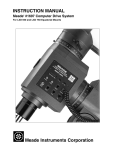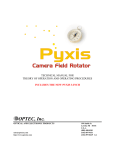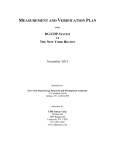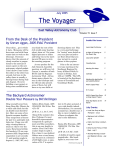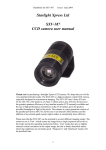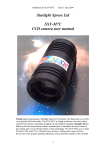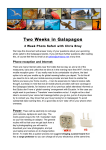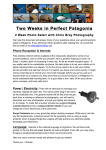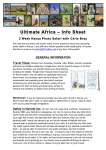Download Santa Barbara Instrument Group ST-5C User`s guide
Transcript
MODEL PFE-1 CCD/TELESCOPE ADAPTER Technical Manual and User’s Guide OPTEC, Inc. OPTICAL AND ELECTRONIC PRODUCTS [email protected] http://www.optecinc.com 199 Smith St. Lowell, MI 49331 U.S.A. (616) 897-9351 (616) 897-8229 FAX Figure 1-1. Model PFE-1 shown with Lynxx PC and Celestron 8" Telescope. TABLE OF CONTENTS Revision 6 - January 2000 Section 1.0 2.0 3.0 4.0 5.0 6.0 7.0 8.0 INTRODUCTION. . . . . . . . . . . . . . . . . . . . . . . . . . . . . . . . . . . . . . . . . . . . . . . .. THEORY OF OPERATION. . . . . . . . . . . . . . . . . . . . . . . . . . . . . . . . . . . . . . . . . 2.1 Purpose of the PFE-1. . . . . . . . . . . . . . . . . . . . . . . . . . . . . . . . . . . . . . . . .. 2.2 Basic Mechanical Design. . . . . . . . . . . . . . . . . . . . . . . . . . . . . . . . . . . . . . . INSTALLATION PROCEDURES. . . . . . . . . . . . . . . . . . . . . . . . . . . . . . . . . . . .3.1 Mounting the PFE-1. . . . . . . . . . . . . . . . . . . . . . . . . . . . . . . . . . . . . . . . . .. 3.2 Mounting Kits for CCD Cameras. . . . . . . . . . . . . . . . . . . . . . . . . . . . . . . . 3.3 Reticle alignment. . . . . . . . . . . . . . . . . . . . . . . . . . . . . . . . . . . . . . . . . . . . . TROUBLE-SHOOTING GUIDE. . . . . . . . . . . . . . . . . . . . . . . . . . . . . . . . . . . . .JOHNSON UBVRI FILTERS. . . . . . . . . . . . . . . . . . . . . . . . . . . . . . . . . . . . . . .. WING FILTERS. . . . . . . . . . . . . . . . . . . . . . . . . . . . . . . . . . . . . . . . . . . . . . . . .STRÖMGREN . FILTERS . . . . . . . . . . . . . . . . . . . . . . . . . . . . . . . . . . . . . . . . . .. PFE-1A AUTOMATIC OPTION . . . . . . . . . . . . . . . . . . . . . . . . . . . . . . . . . . . .8.1 . Physical Characteristics. . . . . . . . . . . . . . . . . . . . . . . . . . . . . . . . . . . . . . . . 8.2 Determining Filter Position . . . . . . . . . . . . . . . . . . . . . . . . . . . . . . . . . . . . . 8.3 Connecting & Operating the Stepper Motor. . . . . . . . . . . . . . . . . . . . . . . .. 8.4 Using the SAA1027 Stepper Driver . . . . . . . . . . . . . . . . . . . . . . . . . . . . . . APPENDICES A. PFE-1A Mounting Kit Instructions . . . . . . . . . . . . . . . . . . . . . . . . . . . . . . i Page 1 3 3 4 7 7 7 7 9 11 15 16 18 18 18 19 19 A-1 LIST OF FIGURES Figure 1-1 1-2 2-1 8-1 PFE-1 shown with Lynxx PC and Meade 8" Telescope. . . . . . . . . . PFE-1 CCD Photometer System and Accessories. . . . . . . . . . . . . . Cross-Sectional View of the PFE-1 mounted with CCD camera. . . Typical Stepper Control Curcuit Using the SAA1027. . . . . . . . . . . . Page Cover 2 4 20 LIST OF TABLES Table 5-1 5-2 5-3 5-4 6-1 7-1 7-2 8-1 8-2 8-3 Physical Characteristics of Optec UBVRI Filters. . . . . . . . . . . . . . Standard UBVRI Response Functions According to Johnson. . . . . UBVRI Response Functions of Optec Filters. . . . . . . . . . . . . . . . . Filter Transmission and Detector Responsivity in A/W. . . . . . . . . Specifications for Wing Filters. . . . . . . . . . . . . . . . . . . . . . . . . . . . Optical Specifications of the Strömgren Filters. . . . . . . . . . . . . . . . Physical Specifications of the Strömgren Filters. . . . . . . . . . . . . . . Specifications for Model PF35-48C Stepper Motor. . . . . . . . . . . . Function and Color Code of Motor Wires. . . . . . . . . . . . . . . . . . . . Number and Function for Motor Control Cable Connector. . . . Pin ii Page 11 12 13 14 15 16 16 18 19 20 SECTION 1.0 INTRODUCTION The recent advent of affordable astronomical CCD cameras has opened whole new opportunities in the area of stellar and extended object photometry. The small format CCD cameras now being manufactured by companies such as Meade and Santa Barbara Instrument Group are examples of the new low-cost cooled-chip astronomical cameras. Regrettably, with these cameras alone it is difficult to find and center objects, focus the camera, and, most importantly for photometry, insert filters into the light path. Optec has developed the Model PFE-1 Photometric Front-End to provide the much needed coupling between telescope and CCD camera head. With the PFE-1, easy and accurate photometric quality imaging is finally possible. The Model PFE-1 was originally designed specifically for the Lynxx PC CCD camera systems, but has now been adapted for many small format cameras as well. Consult the current price list for additional adapter kits for new cameras supported by the PFE-1. The PFE-1 is a complete system with many filter options, a 0.5x telecompressor and 3x tele-extender options, and a fully automated filter slider option. 1 Figure 1-2. PFE-1A CCD Photometer System. 2 SECTION 2.0 THEORY OF OPERATION 2.1 PURPOSE OF THE MODEL PFE-1 Two of the most serious limitations to doing photometry with the small format CCD cameras are small field sizes and lack of a convenient way to insert photometric filters into the light path. The PFE-1 provides an off-the-shelf solution to both these problems. The TC-211 CCD chip used in the SBIG ST-4 and Lynxx PC series cameras has an array of 165 pixels by 192 pixels. The chip is only about 1/10th inch square and therefore offers a very small field-of-view. Finding and centering an object can be difficult without some sort of pre-viewer. Off-axis guiders do not provide full-field views and are of limited use. However, the eyepiece of the PFE-1 provides a full field view (approximately 0.4° with an 8" f/10) and an illuminated reticle which exactly defines the CCD detector field of view. Locating and centering an object with the PFE-1 is as simple as looking through the eyepiece, positioning the telescope, and opening the flip-mirror. Because of the limited field size, to properly perform differential photometry a separate image is often required for both the check and comparison stars. To effectively double the field-of-view, Optec offers the 0.5X telecompressor (stock no. 17610) mounted in a removable 1¼" telescope coupler. This option can be used with light cones of f/10 or higher without vignetting when using cameras having CCD's no larger than about 3.3mm by 2.4mm size. For planetary imaging, a 3x tele-extender (stock no. 17611) triples the effective focal length of the telescope system. A well corrected negative achromat is used in the tele-extender for unparalled planetary images. The other important issue for any photometric use of a CCD is filters. The PFE-1 has a filter port directly behind the flip-mirror which allows the use of ½" diameter photometric filters. The standard PFE-1 requires the filters to be mounted in 2-position filter sliders (stock no. 17050). The automated version PFE-1A includes a stepper motor and can use the 6-position filter sliders which are controlled by the SSPCARD and computer. See Section 9.0 for full details of the automated option. Johnson, Strömgren, Wing, and Hß filters are available in ½" diameter sizes directly from Optec. Refer to Sections 5.0 through 8.0 for additional information on our filter specifications for photometry. 3 2.2 BASIC MECHANICAL DESIGN Figures 2-1 shows cross-sectional views of the PFE-1 when mounted to a CCD camera head. Light enters the PFE-1 through the 1¼ inch telescope adapter and is directed either to the focusing eyepiece or the CCD sensor by means of a flip-mirror. The focusing eyepiece consists of a 1-inch (25.4mm) focal length Ramsden and a reticle with a precisely etched square that defines the CCD field of view. A green LED illuminates the reticle from the side. After a star is positioned in the reticle, the flip mirror is rotated to expose the CCD. An exposure may now by made using the camera's control software. Figure 2-1. Cross-sectional view of the PFE-1A mounted to a CCD camera. The removable 1¼-inch telescope coupler attaches to any standard 1¼ inch focuser. An optional 2-inch focusing mount adapter is available from Optec for attachment to the larger format telescope focusers. The standard 1¼-inch coupler can be replaced with a removable 1¼-inch coupler containing a 0.5X telecompressor lens (stock no. 17610) or a 3X teleextender lens (stock no. 17611). 4 On the bottom of the PFE-1 flip mirror/eyepiece assembly is an input jack for the 12 VDC required to provide power to the reticle LED. The external DC power supply adapter should be plugged in before operation. To adjust the reticle brightness on the PFE-1, use a small screwdriver to turn the pot next to the power input jack. The PFE-1A has an adjustment knob to facilitate changing the reticle brightness. For the PFE-1, a two-position filter slider is mounted between the flip mirror and the CCD. Any pair of filters selected by the user before delivery can be mounted in the slider. Since the slider is easily pulled out of the unit, sliders with other combinations of filters can be inserted. The automated PFE-1A uses a 6-position filter slider made of a special self-lubricating material. A rack mounted on the slider meshes with a bevel gear connected to the stepper motor which is mounted beneath the main flip-mirror block. The 6-position filter sliders can be pulled out and replaced, but this procedure requires removing one of the filter slider covers. By replacing these larger capacity sliders, other photometric filter systems can be accommodated. For most variable star work, a single slider with B and V filters is recommended to begin with. All Optec filters are ½" (12.7mm) in diameter and 7mm thick. See Section 6.0 for a description of the standard UBVRI filter system, Section 7.0 for a description of the MA, MB and MI Wing filter set, and Section 8.0 for a description of the Strömgren uvby fourcolor system. For observations which do not require a photometric filter, the Clear filter should used to insure that the proper optical distance is maintained. Without the Clear filter, the eyepiece would no longer be parfocal with the CCD and stellar images will be out of focus on the CCD sensor. For tri-color imaging (RGB), the Johnson B, V, and R filters can be used. Since each filter blocks the infrared, no separate IR blocking filter is needed. To adapt the Model PFE-1 to the various CCD camera heads available, Optec has designed a number of special mounting kits. These kits provide all the necessary hardware including mounting screws and allen keys for adapting the PFE-1 to a particular camera head. Refer to Appendix A for full instructions regarding the mounting kits. The reticle alignment procedure is detailed in Section 3.3 below. Owners of the Lynxx PC, MC, or Lynxx 2 CCD camera systems should order mounting kit stock number 17612. The standard combination 2"/1¼" telescope coupler provided by SpectraSource Instruments is replaced with a stainless steel camera mounting adapter. This special camera mount is secured to the camera head with three small screws. Specify mounting kit number 17613 for use with a standard C-mount camera. This kit includes a dovetail plate and the (approx.) 1” diameter male C-thread for easy attachment of a typical C-mount video camera. 5 Mounting kit stock number 17614 will adapt the Santa Barbara Instrument Group's Model ST-4 CCD camera to the PFE-1. The 1¼" telescope mount of the ST-4 includes a small cover window and O-ring seal. Mounting kit number 17614 includes a special spacer which contains a replacement cover window and O-ring seal. The stainless steel camera mount then attaches to this spacer and the PFE-1 attaches to the camera mount. Again, all mounting screws and tools are included with the mounting kit. To gain additional field of view, the eyepiece mount used on the PFE-1 is slightly shorter for the ST-4. Be sure to specify mounting kit number 17614 when ordering a PFE-1 for use with the ST-4. Mounting kit stock number 17615 will adapt the Santa Barbara Instrument Group's Model ST-5 CCD camera to the PFE-1. Like the Lynxx-2000, the ST-5 uses the TC-255 CCD and must also have a rectangular reticle mounted in the focusing eyepiece of the PFE-1. Otherwise, mounting kit number 17615 is identical to number 17614 and installs in the same manner. Specify mounting kit number 17616 to adapt the PFE-1 to Meade's Pictor 416 camera. The Pictor 416 uses a Kodak KAF-0400 CCD with a rectangular imaging area. This CCD features 768 x 512 pixels and is 6.90 x 4.60mm in size. When this kit is ordered, the rectangular reticle installed in the PFE-1 matches this shape and size. The stainless steel mount simply screws into the camera head and replaces the existing 1¼" telescope adapter. Owners of the Celestron/SBIG PixCel 255 camera should specify mounting kit number 17618. The PixCel adapter is unique in that it allows the CCD camera to be removed from the PFE-1 much like a standard camera lens. Bot focus and rotational alignment are maintained with camera removal and attachment. This feature allows the PixCel camera to be easily used with both the PFE-1 and the MAXfield 0.33X telecompressor product. Changing between the PFE-1 flip-mirror and the MAXfield telecompressor is as easy as changing a 35mm camera lens. With the proper CCD camera mounting kit, the PFE-1 flip-mirror/eyepiece assembly is then attached to the camera. A dovetail mount on the camera side and four setscrews on the PFE-1 side provide adjustment in the X and Y directions. Reticle alignments are easily done on the Optec optical bench or at the telescope. The CCD camera head completes the portion of the CCD photometer which is installed on the telescope. Typically, a multiconductor cable will connect the CCD photometer head to the host computer or control box. Refer to the user manual provided with your camera or control software. Optec will install the PFE-1 with any camera at no charge and will perform the reticle alignment on an optical bench for initial purchases. Subsequent reticle alignments can be performed for a nominal charge. The entire camera outfit including camera head, control box or interface card, and software should be sent to Optec for installation. Consult the current price list for additional cameras supported. Contact Optec for adapting the PFE-1 to any cameras not shown on the current price list. 6 SECTION 3.0 INSTALLATION PROCEDURES 3.1 MOUNTING THE PFE-1 Installation of the PFE-1 to one of the cameras should be done in a clean area free of dust and other contaminants. The procedure is not difficult and all necessary tools are provided with the mounting kits. However, as with any delicate optical device, care should be taken when handling the camera. For first time buyers who prefer not to attempt mounting the PFE-1, Optec will perform the installation and reticle alignment free-of-charge. This will, of course, require sending the camera head and control electronics to Optec. Re-alignments will also be performed for a nominal fee. Call Optec for details. 3.2 MOUNTING KITS FOR CCD CAMERAS Optec offers a variety of mounting kits for the various CCD cameras which are compatible with the PFE-1. Consult the current price list for a list of the latest cameras supported. Appendix A provides step-by-step instructions for attaching the mounting plate to the camera. 3.3 RETICLE ALIGNMENT After attaching the CCD camera to the mounting plate Note that there are four setscrews around the square body of the PFE-1 directly in front of the CCD camera head. These setscrews allow adjustment in the X and Y directions. Rough alignment should bring the image as viewed through the eyepiece fairly close to the image seen on the computer monitor. The camera head may need to rotated in the X-Y mount slightly to match up the orientation. To perform the reticle alignment at the telescope, slide the telescope coupler into the focus tube of the telescope. If using a Schmidt-Cassegrain type telescope remove the diagonal from the visual back. The X and Y adjustments should be fairly close from the rough alignment, but the camera will need to be rotated to line up with the square reticle. Be sure a filter is inserted in the filter port. A Johnson V filter is recommended since this filter most closely matches the photopic response of the eye. 7 In the telescope, locate a fairly bright extended object such as the moon or a distant street lamp and center it in the reticle. Put the control software in the Focus mode and slightly loosen the setscrews to allow camera rotation. Rotate the camera and make the final X-Y adjustments so that the view within the reticle matches the view on the video monitor. The full-frame focus mode works best. Take your time. The reticle alignment can be frustrating if rushed, but if the approach is methodical the entire procedure can be accomplished in about 10 minutes. Tighten the four setscrews securely against the stainless steel dovetail mount. As long as the camera is not removed, no realignment should be necessary. The eyepiece height and orientation is set at Optec for each specific mounting kit. If dust on the reticle is troublesome, remove it by blowing air (canned air for camera cleaning is suggested) through the 1¼" telescope coupler. Do not, in any case, remove the eyepiece from the assembly. 8 SECTION 4.0 TROUBLE-SHOOTING GUIDE The following common problems and solutions have been collected over the years from our customers and our attempts to solve their instrument problems. Before calling us, read through these and relevant sections of this manual to see if an easy solution exists for your errant photometer. The CCD photometer seems to produce erratic results with the I and R filters but appears to work OK with the B and V filters. Read section 3.1 again. In addition to observatory or nearby incandescent light causing problems, high cirrus clouds not visible with the naked eye or an active aurora can cause havoc in the far red and infrared portions of the spectrum and be invisible in the visible portion. The night appears clear but the star count is diminishing with time faster than expected due to changing extinction conditions. A common problem specially with Celestron and Meade telescopes is that a nearly invisible film of condensed water will develop on the corrector plate or main mirror during the night if the dew point is high enough. Usually this fog film can only be seen when a strong light is projected down the front of the telescope and the optics carefully inspected. A hair dryer is a good cure. When using the PFE-1A and moving the filter slider, a clicking noise is heard but the filter slide does not actually move. If the filter slider covers have been removed for any reason, they may be binding against the slider. To check, simply loosen the two pan head screws on either of the covers and move the filter slider from the keyboard. Carefully tighten the screws while ensuring that the slider continues to move. If this does not cure the problem, a return to Optec may be required. The long term performance of the CCD seems to be seasonal. The limiting magnitude during the summer months cannot seem to match the limiting magnitudes during the winter months. This phenomena is due to the nature of the TEC cooler. The coolers on some CCD cameras are not regulated. The operating temperature is much lower during winter nights than during summer nights because ambient temperatures during the summer months may be 20° (or more) higher than typical winter ambient temperatures. With lower operating temperatures, 9 the S/N ratio will be lowered. Remember, for each 10°C drop in operating temperature a gain of about one stellar magnitude is achieved in limiting magnitude. The focus seems to shift significantly throughout the evening. Focus is a common problem among the Schmidt-Cassegrain type telescopes. With the folded optical path of the SCT, slight thermal changes have a significant effect on the overall focus of the system. You should routinely check the focus by using the focus mode of the data acquisition software. Most of the standard CCD control software packages offer a focus mode. An even better solution is the Optec TCF temperature compensating focuser. Visit the Optec website at www.optecinc.com for more details. The telescope is properly balanced, but in certain directions the tracking seems less than adequate. With CCD imaging, proper balance and polar alignment is essential. Any slight movement in declination or right ascension can result in a blurred image. Remember that each pixel is only about 10 microns, so even a slight nudge will show up in the final image. Try fastening the cables of the CCD camera head directly to the telescope fork arms with tape or zip-ties. The key is to remove as much stress from the photometer head as possible. Another safety tip for SCT owners is to add a second thumbscrew to the visual back. Drill and tap the hole such that the two thumbscrews are 90° apart. When installing the CCD photometer tighten both thumbscrews to avoid a catastrophic fall. When observing a number of faint variables, glare from the reticle makes it difficult to center the object. PFE-1A users have the luxury of simply adjusting the reticle brightness with the large knob on the bottom of the unit. Standard PFE-1 users will need a small screwdriver to adjust the pot on the underside of the unit near the reticle power supply jack. 10 SECTION 5.0 JOHNSON UBVRI FILTERS The UBVRI filter system established by Johnson is generally followed today and defines color bands in the spectrum interval from 300 to 1200 nm. Table 5-2 lists the filter-detector responses of this system as originally established by Johnson. Filter-detector response is defined as the normalized product of filter transmission times detector response for each wavelength interval. Table 5-3 lists the response functions of the UBVRI filters and Table 54 lists the filter-detector responses for the filters used with the Texas Instruments TC-211 CCD device. The OPTEC UBVRI filters are all made from combinations of Schott colored glass. The glass types and thickness for each filter has been computer optimized for the best fit with the Johnson standards. As can be seen from Tables 5-2 and 5-3, the B, V, R and I filters match closely the standard Johnson values and give correspondingly small correction coefficients. Blocking the red leak of the glass used in the U filter results in loss of UV transmission from 300 to 350 nm. The filter is still useful for comparison purposes even though it does not transform into the standard Johnson system precisely. It is interesting to note that the U filter is the most difficult one to transform accurately for all observers including those with photomultiplier systems. UV transmission through the atmosphere varies considerably and any optical glass in the telescope (corrector lens) or photometer will absorb light shorter than 350 nm making accurate U magnitude determinations difficult at best. For those persons interested in the exact filter transmission and detector responsivity, Table 5-4 has been prepared using the latest filter and detector batch data. Filter characteristics are subject to change since we continually review our filter formulas and attempt to achieve smaller transformation coefficients. Flatness Surface Quality Diameter Thickness 6 fringes maximum scratch and dig 80-50 12.7 mm 7 mm Table 5-1. Physical Characteristics of Optec UBVRI Filters. 11 nm U B V R I 300 310 320 330 340 350 360 370 380 390 400 410 420 440 460 480 500 520 540 560 580 600 620 640 660 680 700 720 740 760 780 800 820 840 860 880 900 920 940 960 980 1000 1020 1040 1060 1080 1100 1120 1140 0.00 0.10 0.61 0.84 0.93 0.97 1.00 0.97 0.73 0.36 0.05 0.01 0.00 ------------------------------------------------------------------------------------------------------------------------------------------------- ------------------------0.00 ----0.11 ----0.92 ----1.00 0.94 0.79 0.58 0.36 0.15 0.04 0.00 --------------------------------------------------------------------------------------------------------------------- --------------------------------------------------------0.00 0.02 0.38 0.91 0.98 0.72 0.62 0.40 0.20 0.08 0.02 0.01 0.01 0.01 0.00 --------------------------------------------------------------------------------- --------------------------------------------------------------------0.00 0.06 0.28 0.50 0.69 0.79 0.88 0.94 0.98 1.00 0.94 0.85 0.73 0.57 0.42 0.31 0.17 0.11 0.06 0.04 0.02 0.01 0.00 ------------------------------------- ----------------------------------------------------------------------------------------------------0.00 0.01 0.17 0.36 0.56 0.76 0.96 0.98 0.99 1.00 0.98 0.93 0.84 0.71 0.58 0.47 0.36 0.28 0.20 0.15 0.10 0.08 0.05 0.03 Table 5-2. Standard UBVRI Response Functions According to Johnson. 12 nm U B V R I 300 310 320 330 340 350 360 370 380 390 400 410 420 440 460 480 500 520 540 560 580 600 620 640 660 680 700 720 740 760 780 800 820 840 860 880 900 920 940 960 980 1000 1020 1040 1060 1080 1100 1120 1140 0.00 0.00 0.00 0.13 0.33 0.50 0.77 1.00 0.92 0.53 0.00 0.00 0.00 ------------------------------------------------------------------------------------------------------------------------------------------------- --------------------0.00 0.02 0.10 0.22 0.42 0.60 0.72 0.87 1.00 0.76 0.50 0.33 0.17 0.08 0.05 0.05 ----------------------------------------------------------------------------------------------------------------- --------------------------------------------------------0.00 0.00 0.52 0.89 1.00 0.96 0.75 0.36 0.13 0.04 0.00 0.00 0.00 ----------------------------------------------------------------------------------------- ------------------------------------------------------------------------0.00 0.06 0.27 0.50 0.63 0.85 1.00 1.00 0.88 0.84 0.75 0.57 0.38 0.24 0.18 0.14 0.09 0.05 0.03 0.01 0.01 0.00 ------------------------------------- ----------------------------------------------------------------------------------------------------0.00 0.00 0.00 0.00 0.11 0.52 0.80 0.95 1.00 0.89 0.70 0.57 0.41 0.28 0.20 0.15 0.10 0.06 0.04 0.02 0.01 0.00 0.00 0.00 Table 5-3. UBVRI Response Functions of the Optec Filters. 13 nm U B V R I DET. A/W* 300 310 320 330 340 350 360 370 380 390 400 410 420 440 460 480 500 520 540 560 580 600 620 640 660 680 700 720 740 760 780 800 820 840 860 880 900 920 940 960 980 1000 1020 1040 1060 1080 1100 1120 1140 0.00 0.00 0.00 0.16 0.28 0.37 0.48 0.49 0.39 0.17 0.00 --------------------------------------------------------------------------------------------------------------------------------------------------------- --------------------0.00 0.04 0.14 0.28 0.41 0.50 0.55 0.60 0.57 0.39 0.21 0.11 0.05 0.02 0.01 0.01 ----------------------------------------------------------------------------------------------------------------- ------------------------------------------------------------0.00 0.49 0.74 0.72 0.60 0.40 0.21 0.08 0.02 0.00 0.00 0.00 ----------------------------------------------------------------------------------------- ------------------------------------------------------------------------0.00 0.04 0.16 0.33 0.44 0.50 0.53 0.51 0.46 0.41 0.34 0.27 0.21 0.16 0.11 0.08 0.06 0.04 0.03 0.02 0.01 0.01 0.01 0.01 ----------------------------- ------------------------------------------------------------------------------------------------------------0.00 0.00 0.08 0.45 0.81 0.90 0.91 0.90 0.89 0.87 0.84 0.81 0.77 0.72 0.66 0.57 0.49 0.38 0.28 0.20 0.14 0.08 ------------0.013 0.019 0.022 0.026 0.033 0.038 0.050 0.058 0.063 0.070 0.085 0.095 0.115 0.145 0.165 0.190 0.220 0.255 0.235 0.220 0.260 0.290 0.300 0.295 0.315 0.340 0.325 0.275 0.235 0.250 0.260 0.235 0.185 0.155 0.115 0.082 0.062 0.048 0.035 0.026 0.017 0.015 0.010 ------------- Table 5-4. Filter Transmission and Detector Responsivity in A/W. * Approximate values for a typical charge coupled device. 14 SECTION 6.0 WING FILTERS With the cooperation of Dr. Robert F. Wing of Ohio State University, Optec has designed three filters for the SSP-3 photometer which are useful in measuring the absorption of TiO (titanium oxide), and the true color temperature of late type stars such as Miras. These 1 three filters labeled MA, MB and MI comprise a subset of the Wing 8-color system . See Table 6.1 for filter specifications. It is widely known that the B-V color index of stars with spectral type K5 to M8 is nearly constant although the surface temperature of stars in this range vary considerably. The cooler the surface temperature of these stars the greater the TiO absorption in the visual band, which prevents the color index from becoming redder. As a result, the common B and V magnitude contain little useful information about these stars. Used together, the MA and MB filters measure the amount of TiO absorption in the star's outer atmosphere. The MA filter is centered on an absorption band at 712 nm and the MB filter is centered just off the band and on the continuum at 754 nm. The ratio of readings taken with these filters is proportional to the amount of TiO absorption. The MI filter is centered on the continuum at 1025 nm. Readings taken with this filter and the MB filter can be used together to measure the slope of blackbody curve between these two points, and thus the temperature of the star may be calculated. Because these stars radiate most of their energy in the infrared and the TC-211 CCD chip is sensitive for part of this band, very good stellar images can be obtained with these filters when only marginal images are obtained in the Johnson B and V bands. This is partially true because the amount of background light from the atmosphere due to scatter from the moon or ground lights is extremely low in the infrared wavelengths. Thus, good Wing photometry can be performed even when B and V photometry is impossible because of bright background sky noise. FILTER NAME MA MB MI CENTER WAVELENGTH BANDPASS 1/2T POINTS 712 nm 754 nm 1025 nm 10 nm 10 nm 40 nm PEAK TRANSMISSION 75 % 75 % 55 % Table 6-1. Specifications for Wing Filters. 1 Wing, R. F., 1971, Proceedings of the Conference on Late Type Stars,ed. G.W. Lockwood and H. M. Dyck (KPNO Contribution No. 554), p. 145. 15 SECTION 7.0 STRÖMGREN FILTERS The Strömgren uvby is the most widely used intermediate-band photometric system and is often used instead of the Johnson UBV system. The letters u, v, b, y refer to the colors ultraviolet, violet, blue and yellow respectively. Because these filters have a narrow passband, the system is totally filter defined, and variations in detector spectral response, telescope transmission, and the second order terms used for the extinction corrections and the transformation equations can be safely ignored. In addition, the use of these filters provides more useful astrophysical information than the Johnson UBV system. The Strömgren filters offered by Optec are manufactured by Spectro-Film of Woburn, Massachusetts to our specifications. Spectro-Film has been making the Strömgren filters for professional observatories worldwide for the last 10 years and is considered a primary source for these filters. When used with any CCD camera these filters will match the results from most photometry programs throughout the world. Table 7-1 lists the optical specifications of the Strömgren filters. Table 7-2 lists the physical specifications of the Optec Strömgren filters. OPTICAL SPECIFICATIONS Filter u v b y Center Wavelength 342 nm 410±2 nm 470±2 nm 550±2 nm Bandpass 25 nm 16±1.6 nm 19±1.9 nm 24±2.4 nm Type 6mm UG11 + 1mm WG345 interference interference interference Table 7-1. Optical specifications of the Strömgren filters. The vby filters are multiple cavity interference type using dielectric quarter wave stacks with spacers of metal film. They have excellent transmission characteristic and long life when properly stored. However, all interference filters can be damaged when exposed to high humidity for long periods of time. When not used, these filters should be stored in a glass jar with a small amount of desiccant added to keep the air dry. In such an environment, these filters will last virtually forever. PHYSICAL SPECIFICATIONS Diameter Thickness Surface Quality Wedge 12.7±0.15 mm 7.0±0.3 mm 80-50 Not to exceed 5 ARC minutes Table 7-2. Physical specifications of the Strömgren filters. 16 The u filter is made from 2 pieces of Schott colored glass. The first glass of UG11 defines the red side of the pass band and the WG345 defines the blue side. The small amount of red leak of the UG11 glass beyond 700 and 750 nm should not be a source of error except for very red stars. The surface of the UG11 glass has poor resistance to weathering (humidity) and must be protected in a manner similar to the vby filters. Unlike the interference filters which cannot be restored, the weathered surface of this filter can be repolished. If a small amount of weathering is observed, a white haze on the surface, a Q-tip with jewelers rouge and water can normally repolish the surface. Use light pressure and blow dry the filter immediately afterwards. A paper entitled "A Short Tutorial on Strömgren Four-Color Photometry" by Dr. David Crawford has been reprinted and is available free of charge. Contact Optec for details. 17 SECTION 8.0 PFE-1A AUTOMATIC OPTION 8.1 PHYSICAL CHARACTERISTICS The PFE-1A CCD photometer allows for automatic selection of filters using the 6-position filter sliders. A small 4-phase stepper motor is located below the flip mirror of the camera head and provides the torque and positioning accuracy needed to exactly center the desired filter. A bevel gear arrangement connects the stepper to the filter slider. The 12 VDC power requirement of the stepper motor is supplied through a 9-pin circular Amp connector, as are the four stepper control lines. The important physical and electrical specifications for the motor used in the PFE-1A is listed in Table 8-1. Number of Phases Step Angle (full step) Steps per Revolution Holding Torque Operating Temp. Range DC Operating Voltage Resistance per Winding 4 7.5 degrees 48 2.8 oz.-in. -15 to +50° C 12 volts 70W Table 8-1. Specifications for Model PF35T-48C Stepper Motor from Nippon. 8.2 DETERMINING FILTER POSITION Each filter position is separated by 33 full steps of the stepper motor. In order to determine position, 165 or more full steps in either direction are delivered by the stepper motor to home the slider against one side of its mounting. After this homing procedure, the computer or controller determines position by keeping track of the number of 33 step intervals from the home position. Stalling the motor against its mounting will not harm the motor or mounting covers in any way. The pulse rate to the stepper can be varied under computer control and the optimum rate (fastest position change without losing steps due to slider inertia), with or without acceleration, must be determined experimentally. For a first approximation, try a steady pulse rate of 100 steps per second and observe whether the positions are kept accurately when changed repeatedly. 18 8.3 CONNECTING & OPERATING STEPPER MOTOR If the SSPCARD and associated cable are purchased with the PFE-1A, this section can be disregarded. A 9-pin AMP connector is supplied with the PFE-1A for those wishing to design and build their own stepper controller or computer interface. Table 8-2 lists the pin numbers of the 9pin connector which are connected to the motor and the proper step sequence that these lines must follow. FUNCTION MOTOR WIRE COLOR PIN NO. FOR PFE-1A CONN. STEP SEQUENCE C.W. ROT. 1 2 3 4 1 Q3 Q1 Q4 Q2 black orange brown yellow 7 On Off Off On On 4 On On Off Off On 3 Off On On Off Off 2 Off Off On On Off COMMON connect red & red 1 Table 8-2. Function and Color Code of Motor Wires Inside Unit. Table 8-3 lists the pin numbers of the 9-pin AMP connector and their associated function. Either a shielded or unshielded 9-wire cable can be used. Since the amount of current used by the stepper motor is just a few hundred milliamps, small gauge wire can be used in the cable. Cables of lengths up to 100 feet have worked successfully. 8.4 USING THE SAA1027 STEPPER DRIVER The Signetics SAA1027 stepper motor drive IC is available from Optec for a small charge. This 16-pin IC allows easy control of the stepper motor and requires only a few external resistors, a 12 V DC power source and a two control lines from the computer or controller. A typical circuit is shown in Figure 8-1. 19 PIN NUMBER 15-PIN 9-PIN SUB-D CIRC. 1 1 2 3 3 7 4 2 5 5 6 6 7 4 8 8 9 9 CABLE COLOR Red Orange Purple Brown N/A White Blue Black N/A FUNCTION +12 Volts DC Q4 - Pin #11 on SAA1027 Q3 - Pin #9 on SAA1027 Q2 - Pin #8 on SAA1027 Not Connected +12 Volts DC Q1 - Pin #6 on SAA1027 Power Ground Not Connected Table 8-3. Pin Number and Function for the Motor Control Cable Connector. Figure 8-1. Typical Stepper Control Circuit Using the SAA1027. 20 APPENDIX A PFE-1 MOUNTING KIT INSTRUCTIONS MOUNTING KITS FOR THE SPECTRASOURCE INSTRUMENTS CAMERAS The Lynxx PC, Lynxx MC, Lynxx 2, and Lynxx 2000 camera heads are shipped with a combination 1¼"/2" telescope coupler which must be removed. Loosen and remove the coupler by removing the three socket cap screws holding the coupler to the camera face. Install the stainless steel mounting plate with the dovetail mount away from the camera face using the three 1/4" long flat head socket screws. Next, attach the PFE-1 to the dovetail by tightening each of the four setscrews on the PFE-1. Roughly center the camera by looking down the 1¼" coupler. You may need to flip the mirror out of the way and remove the filter slider. The CCD photometer is now ready for the reticle alignment (Section 3.3). MOUNTING KITS FOR THE SBIG ST-4 AND ST-5 CAMERAS To mount the PFE-1 to the ST-4, the existing 1¼" coupler with clear glass window must be removed. Since this procedure directly exposes the CCD chip, it should only be done in a dust-free environment. To reduce the moisture content inside the CCD chamber and reduce the possibility of frosting, the existing 1¼" coupler should only be removed when the relative humidity is below 50%. Carefully loosen and remove the four socket cap screws. Gently lift the telescope coupler up and away from the camera body. This will expose the CCD chip directly. Next, position the new camera mount with O-ring and clear glass window directly over the CCD. Line up the screw holes and install the four 5/8" long socket cap screws. Tighten snugly. Next, install the stainless steel mounting plate with the dovetail mount away from the camera face using the three 1/4" long flat head socket screws. Finally, attach the PFE-1 to the dovetail by tightening each of the four setscrews on the PFE1. Roughly center the camera by looking down the 1¼" coupler. You may need to flip the mirror out of the way and remove the filter slider. The CCD photometer is now ready for the reticle alignment (Section 3.2). Note: the eyepiece height is lower for the ST-4 than for the Lynxx cameras. This is due to the fact that the TC-211 chip is actually mounted on the face of the camera head rather than within the camera head as with the Lynxx cameras. Thus, the chip can actually be brought closer to the flip mirror of the PFE-1. The eyepiece height is set at Optec according to the mounting kit purchased. Do not attempt to adjust the eyepiece orientation or height. 1 MOUNTING KIT FOR SBIG ST-5C AND CELESTRON PIXCEL 237/255 CAMERAS The Celestron PixCel 237 and 255 cameras use a three piece mounting kit for attaching to the PFE-1. SBIG sells the PixCel 237 camera directly as the Model ST-5C. The purpose of the three piece mount is to allow easy disconnect of the PFE-1 and attachment of either the MAXfield 0.33X or WideField 0.5X telecompressors to the CCD camera. Optec part number 3486 is required. To install the mounting plate to the PixCel or ST-5C camera, assemble the three pieces by first placing the PixCel adapter into the PFE-1 and tighten the four setscrews in the PFE-1. Second, lay the PixCel T-adapter onto the piece just attached to the PFE-1 with the alignment pin engaging the hole in the T-adapter. Third, screw the PixCel retainer onto the assembly and tighten gently. Now, screw the PixCel camera (or ST-5C) onto the T-adapter and tighten so that the camera is secure and not easy to rotate. DO NOT OVERTIGHTEN OR USE ANY LOCTITE COMPOUND. The camera can now be rotated to the proper position by loosening the four setscrews holding the adapter and rotate the entire camera and adapter assembly. Tighten the four setscrews again. Refer to Section 3.3 for reticle alignment procedures. Once the reticle is aligned and the proper rotation is obtained the CCD camera can be removed by loosening the PixCel retainer until the CCD camera is free. Be careful not to drop it. The camera can now be removed and installed at will without losing the camera alignment to the reticle. Keep the retainer threads clean and lubricated with contact cleaner for best operation. For older PixCel cameras using the SBIG color wheel a separate IR blocking filter may have been provided. (Current SBIG ST-5C models use RGB fitlers with IR cut coatings on each filter). The separate 1¼" IR blocking filter can be screwed into the T-adapter before the CCD camera is attached. To maintain parfocality with the reticle, either the IR blocking filter or the Clear 1¼" window (Optec stock no. 17619) must be used for these older cameras. MOUNTING KITS FOR MEADE CAMERAS The Meade Pictor 416XT and 216XT cameras are shipped from the manufacturer with a 1¼" barrel (telescope coupler) with a T-thread. This piece can be removed from the camera by simply unscrewing it. Replace it with one of the mounting kits provided by Optec. The Pictor 416XT mount is a single piece adapter (Optec stock no. 17616) while the Pictor 216XT mount is a three-piece design (Optec stock no. 17617). Thread the T-thread side of the adapter into the camera head and tighten snugly. 2 Next, attach the PFE-1 to the dovetail by tightening each of the four setscrews on the PFE-1. Roughly center the camera by looking down the 1¼" coupler. You may need to flip the mirror out of the way and remove the filter slider. You may now proceed with the reticle alignment (Section 3.3). 3



























